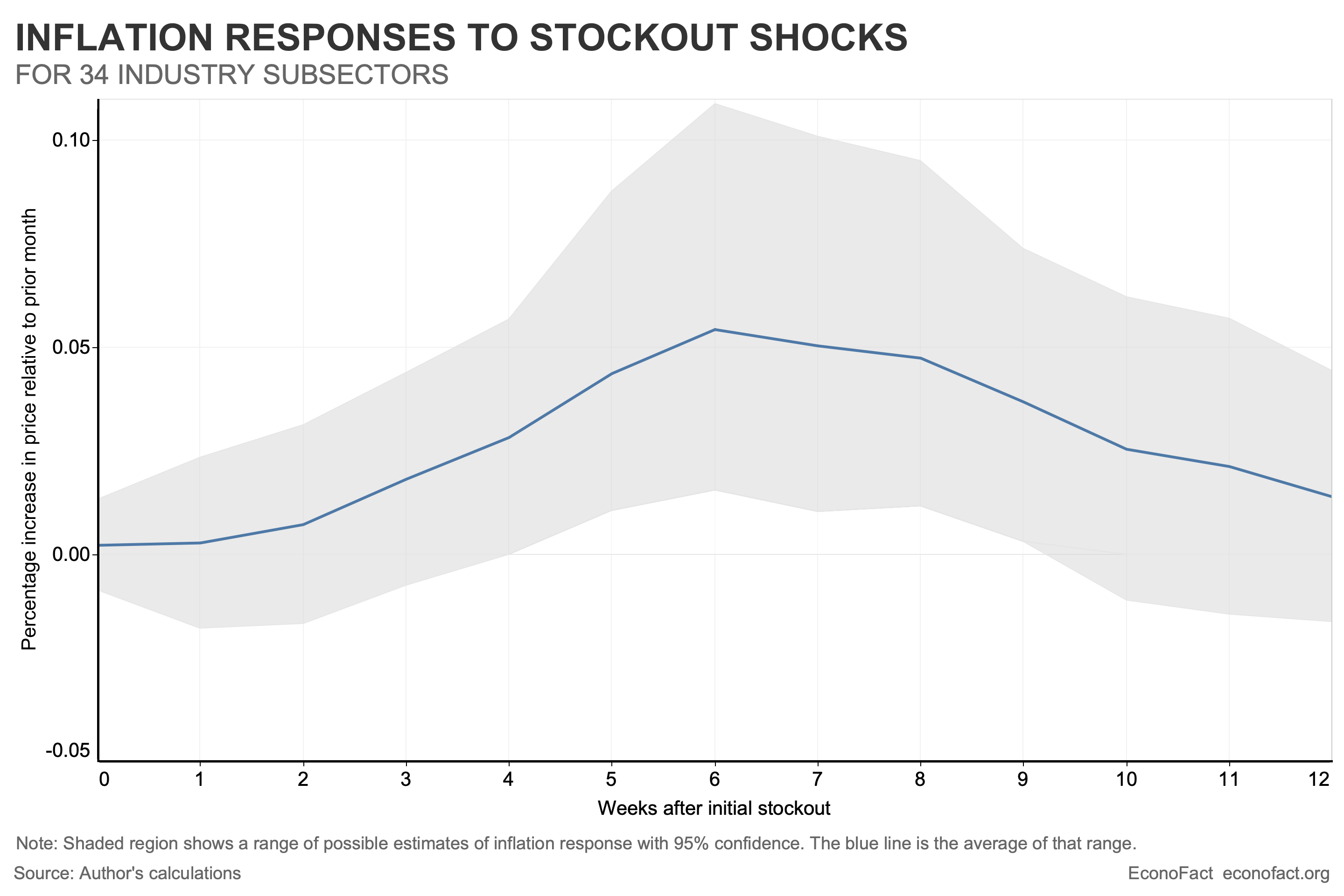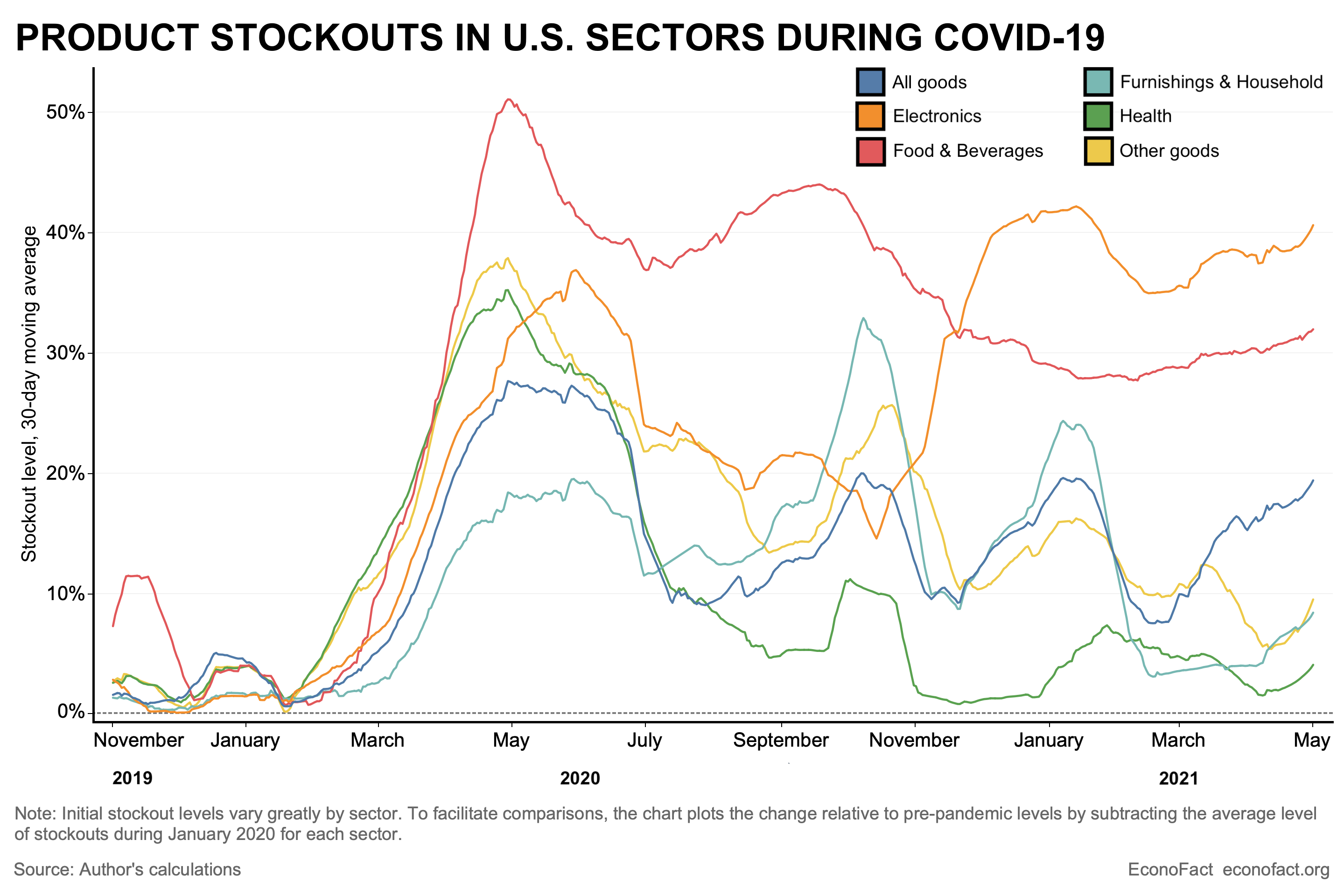Pandemic Shortages and Inflation: From Empty Shelves to Higher Prices
Harvard Business School and Bank of Canada
The Issue:
From the start of the pandemic consumers and retailers have faced shortages in a wide range of goods, from toilet paper to electronics. Economists and policy-makers have highlighted the role that COVID-related supply disruptions can play in fueling price increases. But so far there has been little empirical evidence documenting the extent of shortages across different categories of consumer goods, and whether they have an impact on retail prices and inflation dynamics. Our new research looking at large retailers that have both online and bricks-and-mortar stores provides a more fine-grained picture of the nature of product shortages and their association with rising prices.
COVID supply disruptions, evident in product shortages at the retail level, were an important driver of inflation a year after the start of the crisis.
The Facts:
- Inflation fell slightly in the beginning of the pandemic but then rebounded and rose quickly in the United States as well as in many other countries. In the U.S., inflation rose to 5.3%, as measured by the Labor Department’s consumer-price index in the 12 months through August 2021, after averaging about 1.7% for the past decade. The causes for this spike in inflation have been widely debated (see here and here). Product shortages and supply disruptions are one potential source of increasing prices. Globally, the pandemic caused bottlenecks in shipping networks and disrupted the flow of goods along international supply chains. Domestically, the pandemic increased the cost of business operations and undercut retailers' efforts to manage inventories amid volatile swings in consumer demand. These difficulties could cause higher production costs, difficulties in restocking, and product scarcities, and result in retailers passing costs on to consumers in the form of higher prices.
- Widespread shortages early in the pandemic affected nearly all categories of consumer goods. Using online data collected in seven countries from a sample of large retailers that also have brick-and-mortar stores, we track changes in the availability and prices for a wide range of goods. In our sample of United States retailers, the average of total stockouts of particular types of goods (situations where retailers no longer had those goods available for sale) rose from around 14% of goods in 2019 to over 35% in early May 2020. The size of the increase in stockouts varied across different categories of goods ranging from 19 percentage points for “Furnishings and Household” goods to above 50 percentage points for “Food and Beverages,” in May 2020 (see chart).
- Over time, shortages evolved from “temporary stockouts” in many sectors to “permanent stockouts,” concentrated in fewer sectors. In our data we can detect when product shortages are expected to be temporary — because retailers post messages that a product is "currently unavailable" — as well as more permanent, such as when an item becomes discontinued and disappears from product listings. In the United States, temporary stockouts, which are more visible to consumers, rose quickly from 12% to 22% in March 2020, and then recovered gradually over time. By November, temporary stockouts were back to pre-pandemic levels, and continued to fall further in subsequent months. Permanent stockouts also increased sharply at the beginning of the pandemic, but unlike temporary stockouts, they continued growing: Initially, about 20% of products had been discontinued by the end of April 2020; After decreasing in July, permanent stockouts started to increase again, and by May 2021 they were once again peaking around 20 percentage points over pre-pandemic levels.
- While the availability of most categories of goods recovered gradually in the United States, disruptions have been more persistent in electronics and the food and beverages categories. Electronic goods, which have been particularly impacted by a global computer chip shortage, have seen stockouts surge since October of 2020 and were at near record levels in May of 2021 with stockouts at over 40 percentage points over pre-pandemic levels. Stockouts in the food and beverages sector also remained over 30 percentage points higher as of May 2021, which is consistent with U.S. media articles that have reported the effects of labor and raw material shortages on the sector.

- Have these product shortages been associated with rising prices? At the country-level we observe that the three countries that experienced the most persistent stockouts in our sample — the United States, Canada, and Germany —are also the ones that experienced larger increases in annual inflation rates during this period. Within our sample of goods in the United States, we find that the impact of a stockout on inflation is statistically significant, but occurs gradually and is ultimately transitory. For example, we estimate that an increase in the share of products that are discontinued within a narrow product category, as measured by a permanent stockout rate going from 10% to 20%, initially raises the monthly inflation by about 0.10 percentage points for that category of goods. The impact rises gradually after two weeks, peaks around 6 weeks and dissipates after three months. The impact is higher in sectors where the stockouts have been particularly persistent, such as Food and Electronics. We also find that temporary stockouts, which were more important at the beginning of the pandemic, have a similar effect on price inflation for the category of goods where they occurred. This suggests that costs have been putting upward pressure on prices all along, even though the effects were harder to detect with aggregate statistics when demand was falling. The inflation effects we find in these online prices are likely to extend to brick-and-mortar prices as well, because online and offline prices are similar for large U.S. retailers.
What this Means:
One of the most striking economic implications of the global COVID-19 pandemic is the severe disruption of the supply of goods to final consumers. Temporary disruptions were widespread and easy for consumers to observe in the empty shelves and "product temporarily unavailable" notices that were prevalent at the outset of the pandemic. While temporary shortages tended to dissipate, our research shows that supply disruptions continued with a rising share of permanently discontinued goods concentrated in particular categories. Indeed, the COVID supply disruptions, which are evident in product shortages at the retail level, were still an important driver of inflation a year after the start of the crisis. Although the impact we observe of product shortages on inflation is transitory, lasting only about 3 months, the fact that shortages are persistent in some sectors means that the pressure on prices from shortages has not ceased. Looking ahead, the U.S. inflation outlook depends in part on how quickly these shortages dissipate.

